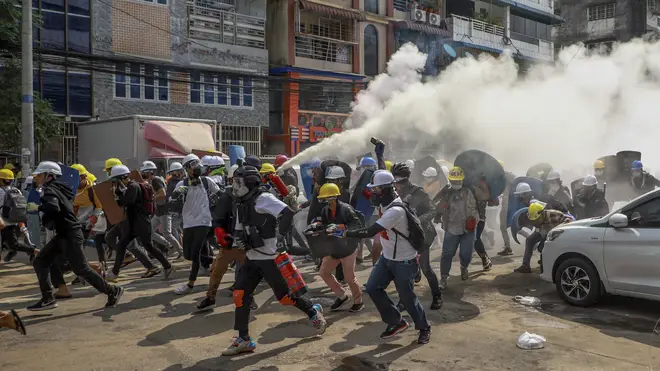
Clare Foges 6pm - 9pm
4 March 2021, 07:44

Demonstrators have regularly flooded the streets since the military seized power and ousted the elected government of leader Aung San Suu Kyi.
Myanmar security forces were seen firing slingshots at protesters, chasing them down and even beating an ambulance crew in video showing a dramatic escalation of violence against opponents of last month’s military coup.
A UN official said 38 people had been killed on Wednesday, a figure consistent with other reports though accounts are difficult to confirm inside the country.
The increasingly deadly violence could galvanise the international community, which has responded fitfully so far.
“Today it was the bloodiest day since the coup happened on February 1. We have today – only today – 38 people died. We have now more than over 50 people who have died since the coup started and more have been wounded,” said the UN special envoy for Myanmar, Christine Schraner Burgener.

Demonstrators have regularly flooded the streets of cities across the country since the military seized power and ousted the elected government of leader Aung San Suu Kyi.
Their numbers have remained high even as security forces have repeatedly fired tear gas, rubber bullets and live rounds to disperse the crowds, and arrested many protesters.
The intensifying stand-off is unfortunately familiar in a country with a long history of peaceful resistance to military rule – and brutal crackdowns. The coup reversed years of slow progress towards democracy in the Southeast Asian nation after five decades of military rule.
The Democratic Voice of Burma, an independent television and online news service, also tallied 38 deaths.
A toll of at least 34 was compiled by a data analyst in Yangon, Myanmar’s biggest city. He also collected information where he could on the victims’ names, ages, home towns, and where and how they were killed.

According to the data analyst’s list, most were in Yangon, where 18 died. In the central city of Monywa, which has turned out huge crowds, eight deaths were reported. Three deaths were reported in Mandalay, the country’s second biggest city, and two in Salin, a town in Magwe region. Mawlamyine, in the country’s southeast, and Myingyan and Kalay, both in central Myanmar, each had a single death.
As part of the crackdown, security forces have also arrested hundreds of people, including journalists. On Saturday, at least eight journalists, including Thein Zaw of The Associated Press, were detained.
A video showed he had moved out of the way as police charged down a street at protesters, but then was seized by police officers, who handcuffed him and held him briefly in a chokehold before marching him away.
He has been charged with violating a public safety law that could see him imprisoned for up to three years.
The escalation of the crackdown has led to increased diplomatic efforts to resolve Myanmar’s political crisis – but there appear to be few viable options. It’s not yet clear if Wednesday’s soaring death toll could change the dynamic.

The UN Security Council is expected to hold a closed meeting about the situation on Friday, council diplomats said. The UK requested the meeting, they said.
Still, any kind of co-ordinated action at the United Nations will be difficult since two permanent members of the Security Council, China and Russia, will almost certainly veto it. Some countries have imposed or are considering imposing their own sanctions.
In addition to the deaths, there have been reports of other violence. In Yangon, a widely circulated video taken from a security camera showed police in the city beating members of an ambulance crew – apparently after they were arrested. Police can be seen kicking the three crew members and thrashing them with rifle butts.
Security forces are believed to single out medical workers for arrest and mistreatment because members of the medical profession launched the country’s civil disobedience movement to resist the junta.